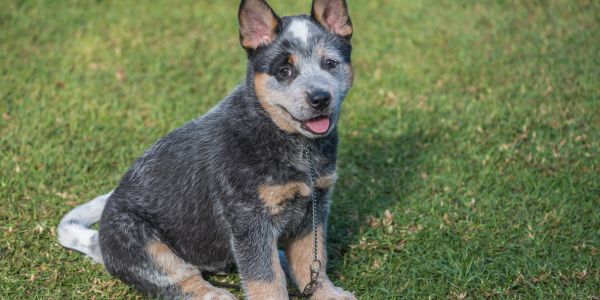Most modern-day breeders set specific height limits on what they consider to be the maximum Blue Heeler size. So, if you are set to be the lucky pet parent of a male Blue Heeler any time soon, expect the dog to reach a height of 18 to 21 inches by the time he reaches maturity. If it is a female, her max height will be 17 to 19 inches. In this article, I will share everything you need to know about Blue Heeler size and weight. These details will help you create the right type of space and environment for your four-legged Australian buddy.
Do you have a specific question about blue heeler size? Then use the table of contents below to jump to the most relevant section. And you can always go back by clicking on the black arrow in the right bottom corner of the page. Also, please note that some of the links in this article may be affiliate links. For more details, check the Disclosure section at the bottom of the page.
Here's what we'll cover:
- A Brief Introduction to the World of Blue Heelers
- How Big Do Blue Heelers Get?
- How Much Should A Blue Heeler Weight?
- When Do Cattle Dogs Stop Growing?
- Blue Heeler Growth Stages
- Australian Cattle Dog growth FAQ
- Q: How big do Blue Heelers get?
- Q: Is there a Blue Heeler size chart available?
- Q: What is the average size of a Blue Heeler?
- Q: How much does a Blue Heeler puppy weigh at 6 months old?
- Q: What is the right weight for a healthy Blue Heeler?
- Q: Are there any common health problems associated with Blue Heeler size?
- Q: How does the growth chart for Australian Cattle Dogs compare?
- Q: Do female Blue Heelers grow to be the same size as males?
- Q: How can I estimate the adult weight and neck size of my Blue Heeler?
- Q: How much should I feed my Blue Heeler to ensure they stay at a healthy weight?
A Brief Introduction to the World of Blue Heelers
Blue Heelers, also known as Australian Cattle Dogs (ACD) or Queensland Heelers, are persistent, high-energy, and highly intelligent herding dogs. They have a compact, muscular build and are known for their loyal and alert nature. This breed is related to the famous Australian Dingo. But, Blue Heelers are typically slightly smaller than Dingoes. Here is a full-grown Dingo vs full-grown Blue Heeler size comparison chart:
| Feature | Dingo | Australian Blue Heeler |
| Height Male | 48 to 60 cm 18 to 24 inches | 46 to 51 cm 18 to 21 inches |
| Height Female | 48 to 60 cm 18 to 24 inches | 43 to 48 cm 17 to 19 inches |
| Weight Male | 23 to 32 kg 50 to 71 pounds | 18 to 20 kg 40 to 50 pounds |
| Weight Female | 23 to 32 kg 50 to 71 pounds | 15 to 19 kg 35 to 45 pounds |
The height of these dogs is measured up to their shoulder blades. To measure your Blue Heeler’s height, make him/her stand straight on a flat surface. Use a measuring tape to measure the dog from the ground to the withers between his/her shoulder blades.
How Big Do Blue Heelers Get?
As you can see from the chart above, by adulthood, your Blue Heeler will weigh anywhere between 40 to 50 pounds (male) or 35 to 45 pounds (female). Here are two ways to predict a fully-grown Blue Heeler’s size and weight while he/she is still a baby:
- Genetics: If you have purchased your Blue Heeler puppy via a breeder, reach out to them and inquire about the sizes of the previous litters. If your breeder knows the parents of your puppy, they can provide precise information on how big you can expect your puppy to get. DNA tests can also predict your Blue Heeler’s maximum size and weight.
- Paw Size: Predicting a puppy’s “max size” by assessing the size of his/her paws is not an exact science. But, many vets can make this prediction. You can do it too. Just look at the paws of your puppy. Do they look oversized next to their body and legs? If yes, then your Blue Heeler still has a lot of growing to do.
A female Blue Heeler’s size will almost always be smaller compared to the males.
How Much Should A Blue Heeler Weight?
According to the American Kennel Club (AKC), the average weight of a blue heeler (fully grown) is anything between 35 to 50 pounds. Since these dogs weigh under 50 pounds and stand less than two feet tall (21 inches maximum), the Australian Blue Heeler is officiallyclassified as a “medium-sized” dog on the AKC spectrum of breeds.
When Do Cattle Dogs Stop Growing?
Your Blue Wheeler puppy will stop growing after 12 months. By their first birthday, your puppy will reach his/her maximum height. Your puppy will become a full-grown Blue Heeler by the time they become 18 to 24 months of age. That is when it will reach its maximum weight.
- Male Blue Heeler Max Weight and Height: 50 pounds and 21 inches.
- Female Blue Heeler Max Weight and Height: 45 pounds and 19 inches.
Since males are larger in size, they usually require two years to put on a healthy weight and finish growing.
Blue Heeler Growth Stages
To help you track and manage your Blue Heeler’s weight and height, I have created the following chart. This Blue Heeler size chart also explains how your dog’s space requirements will evolve with time:
| Age | Weight (lbs.) | Weight (kg) | Height (inches) | Space Requirements |
| 3 months | 12 to 15 | 5 to 5-7 | 12 to 14 | Make sure the sleeping space (crate, playpen, or bed) is big enough for the puppy to lie down, stand up, and move around comfortably. The puppy should be given access to toys and a small play zone by the time he/she is 3 months old. |
| 4 months | 15 to 18 | 7-8 to 5 | 13 to 15 | Give the puppy access to different rooms in the house. |
| 5 months | 20 to 24 | 9 to 11 | 14 to 16 | Give the puppy access to outdoor spaces like yards or gardens. |
| 6 months | 23 to 26 | 10.5 to 12 | 15 to 17 | Upgrade the sleeping space to a large-sized crate or playpen. Take the dog outdoors and give him/her space to run and play. |
| 8 months | 26 to 30 | 12 to 13.5 | 16 to 18 | Keep the same arrangements. Give your growing puppy blankets to him cozy at night. |
| 10 months | 28 to 33 | 13 to 15 | 17 to 19 | Shift the puppy to his “permanent bed.” This can be a large-sized bed or a spacious, 30-square-inch playpen. |
| 1 year | 30 to 35 | 13.5-16 | 18 to 20 | Now your dog has reached 100% of its maximum height. If your dog is comfortable in a big bed, there is no need to change anything. Just make sure that the dog sleeps in a noise-free spot. |
| 2 years | 45 to 50 | 20.5 to 22.5 | 20 | Give your fully grown Blue Heeler regular access to a yard; take them on runs as well. Keep their sleeping spot clean at all times. |
As your Blue Heeler grows older and bigger, its space requirements will evolve. Use this chart to track your Australian cattle dog’s weight and height. In case you feel that your dog is overweight, take them for regular walks in the park. If you feel that your dog is underweight, take them to the vet and get a formal diagnosis.
Australian Cattle Dog growth FAQ
Q: How big do Blue Heelers get?
A: Blue Heelers, also known as Australian Cattle Dogs, are a medium-sized dog breed. They typically reach their full size and weight between 18 and 24 months of age.
Q: Is there a Blue Heeler size chart available?
A: While there isn’t a specific Blue Heeler size chart, you can use a general dog growth chart as a reference to track their growth and development.
Q: What is the average size of a Blue Heeler?
A: The average size of a fully grown Blue Heeler is around 20 inches in height and can weigh between 35 to 50 pounds.
Q: How much does a Blue Heeler puppy weigh at 6 months old?
A: At 6 months old, a Blue Heeler puppy typically weighs between 25 to 35 pounds.
Q: What is the right weight for a healthy Blue Heeler?
A: The right weight for a Blue Heeler depends on their age, size, and individual genetics. It is best to consult with a veterinarian to determine the ideal weight for your specific dog.
Q: Are there any common health problems associated with Blue Heeler size?
A: Blue Heelers, like any other dog breed, can be prone to certain health issues. Some common health problems associated with their genetics include elbow dysplasia, hip dysplasia, and weight-related issues if not properly exercised and fed.
Q: How does the growth chart for Australian Cattle Dogs compare?
A: The growth chart for Australian Cattle Dogs, which includes Blue Heelers, shows a steady growth pattern from puppyhood to adulthood. They continue to grow until they reach their full size, which is usually around 18 to 24 months.
Q: Do female Blue Heelers grow to be the same size as males?
A: Female Blue Heelers generally reach a slightly smaller size compared to males. However, the overall size range for both males and females is considered to be medium to large.
Q: How can I estimate the adult weight and neck size of my Blue Heeler?
A: The adult weight and neck size of a Blue Heeler can vary based on genetics and individual development. Monitoring their current weight and consulting with a veterinarian can help give you an idea of their expected size.
Q: How much should I feed my Blue Heeler to ensure they stay at a healthy weight?
A: The amount of food to feed a Blue Heeler depends on their age, activity level, and individual metabolism. It’s important to feed them a balanced diet recommended by a veterinarian and regularly monitor their weight to avoid overfeeding or underfeeding.
Thanks for the blog graphics: Canva.com
Thanks for the blog graphics: Canva.com
Doghint.com is a participant of several affiliate programs. The list includes (but not limited to) the following: VigLink, Refersion, ShareASale, and Amazon Services LLC Associates Program, an affiliate advertising program designed to provide a mean for us to earn fees by linking to Amazon.com and affiliated sites. Doghint.com does not intend to provide veterinary advice. All published articles are meant for informational purposes only and not substitute the professional veterinary consultation.


